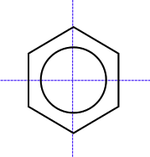Centrosymmetry
This article needs additional citations for verification. (December 2009) |

In crystallography, a point group which contains an inversion center as one of its symmetry elements is centrosymmetric.[1] In such a point group, for every point (x, y, z) in the unit cell there is an indistinguishable point (-x, -y, -z). Such point groups are also said to have inversion symmetry.[2] Point reflection is a similar term used in geometry. Crystals with an inversion center cannot display certain properties, such as the piezoelectric effect.
The following space groups have inversion symmetry: the triclinic space group 2, the monoclinic 10-15, the orthorhombic 47-74, the tetragonal 83-88 and 123-142, the trigonal 147, 148 and 162-167, the hexagonal 175, 176 and 191-194, the cubic 200-206 and 221-230.[3]
Point groups lacking an inversion center (non-centrosymmetric) can be polar, chiral , both or neither.
A polar point group is whose symmetry operations leave more than one common point unmoved. A polar point group has no unique origin because each of those unmoved points can be chosen as one. The unmoved points collectively make a unique anisotropic axis. Polar point groups in crystal include 1, 2, 3, 4, 6, m, mm2, 3m, 4mm, and 6mm.
A chiral (often also called enantiomorphic) point group is one containing only proper (often called "pure") rotation symmetry. No inversion, reflection, roto-inversion or roto-reflection (i.e., improper rotation) symmetry exists in such point group. Chiral point groups in crystal include 1, 2, 3, 4, 6, 222, 422, 622, 32, 23, and 432. Chiral molecules such as proteins crystallize in chiral point groups.
Non-centrosymmetric point groups in crystal 1, 2, 3, 4, 6 are both polar and chiral.
Non-centrosymmetric point groups in crystal -4, -42m, -6, -6m2, -43m are neither polar nor chiral. On the other hand, polar and chiral point groups must be non-centrosymmetric.
See also
References
- ^ Tilley, Richard (2006). "4". Crystals and Crystal Structures. John Wiley. pp. 80–83. ISBN 978-0-470-01821-7.
{{cite book}}: Cite has empty unknown parameters:|laydate=,|separator=,|nopp=,|month=,|laysummary=,|chapterurl=, and|lastauthoramp=(help) - ^ Fu, Liang; Kane, C. "Topological insulators with inversion symmetry". Physical Review B. 76 (4). arXiv:cond-mat/0611341. Bibcode:2007PhRvB..76d5302F. doi:10.1103/PhysRevB.76.045302.
- ^ Cockcroft, Jeremy Karl. "The 230 3-Dimensional Space Groups". Birkbeck College, University of London. Retrieved 18 August 2014.
